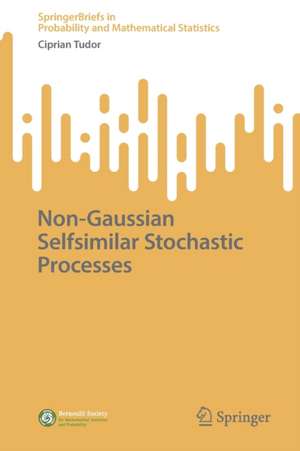Non-Gaussian Selfsimilar Stochastic Processes: SpringerBriefs in Probability and Mathematical Statistics
Autor Ciprian Tudoren Limba Engleză Paperback – 5 iul 2023
Using the Wiener chaos theory and multiple stochastic integrals, the book covers the main properties of Hermite processes and their multiparameter counterparts, the Hermite sheets. It delves into the probability distribution of these stochastic processes and their sample paths, while also presenting the basics of stochastic integration theory with respect to Hermite processes and sheets.
The book goes beyond theory and provides a thorough analysis of physical models driven by Hermite noise, including the Hermite Ornstein-Uhlenbeck process and the solution to the stochastic heat equation driven by such a random perturbation. Moreover, it explores up-to-date topics central to current research in statistical inference for Hermite-driven models.
Din seria SpringerBriefs in Probability and Mathematical Statistics
-
 Preț: 374.30 lei
Preț: 374.30 lei -
 Preț: 348.79 lei
Preț: 348.79 lei -
 Preț: 480.07 lei
Preț: 480.07 lei -
 Preț: 380.25 lei
Preț: 380.25 lei -
 Preț: 472.65 lei
Preț: 472.65 lei -
 Preț: 389.70 lei
Preț: 389.70 lei -
 Preț: 445.88 lei
Preț: 445.88 lei -
 Preț: 378.92 lei
Preț: 378.92 lei -
 Preț: 176.15 lei
Preț: 176.15 lei - 15%
 Preț: 472.36 lei
Preț: 472.36 lei -
 Preț: 479.67 lei
Preț: 479.67 lei -
 Preț: 380.29 lei
Preț: 380.29 lei -
 Preț: 377.35 lei
Preț: 377.35 lei
Preț: 377.73 lei
Nou
Puncte Express: 567
Preț estimativ în valută:
72.29€ • 78.49$ • 60.72£
72.29€ • 78.49$ • 60.72£
Carte tipărită la comandă
Livrare economică 23 aprilie-07 mai
Preluare comenzi: 021 569.72.76
Specificații
ISBN-13: 9783031337710
ISBN-10: 3031337719
Ilustrații: XII, 101 p. 1 illus.
Dimensiuni: 155 x 235 mm
Greutate: 0.17 kg
Ediția:1st ed. 2023
Editura: Springer Nature Switzerland
Colecția Springer
Seria SpringerBriefs in Probability and Mathematical Statistics
Locul publicării:Cham, Switzerland
ISBN-10: 3031337719
Ilustrații: XII, 101 p. 1 illus.
Dimensiuni: 155 x 235 mm
Greutate: 0.17 kg
Ediția:1st ed. 2023
Editura: Springer Nature Switzerland
Colecția Springer
Seria SpringerBriefs in Probability and Mathematical Statistics
Locul publicării:Cham, Switzerland
Cuprins
Introduction.- Chapter 1. Multiple Stochastic Integrals.- Chapter 2. Hermite processes: Definition and basic properties.- Chapter 3. The Wiener integral with respect to the Hermite process and the Hermite Ornstein-Uhlenbeck process.- Chapter 4. Hermite sheets and SPDEs.- Chapter 5. Statistical inference for stochastic (partial) differential equations with Hermite noise.- References.
Notă biografică
Ciprian Tudor is Full Professor at the University of Lille, France. He graduated from the University of Bucharest and earned his PhD degree in probability from Université de La Rochelle in 2002. Following his doctorate, he held positions at the Université Pierre et Marie Curie (Paris 6) and at the Université de Panthéon-Sorbonne (Paris 1), where he obtained his Habilitation in 2006. With a research focus on stochastic processes, particularly Malliavin calculus, self-similar processes, and their applications to statistics, he has authored three monographs and more than 150 scientific publications in well-regarded journals.
Textul de pe ultima copertă
This book offers an introduction to the field of stochastic analysis of Hermite processes. These selfsimilar stochastic processes with stationary increments live in a Wiener chaos and include the fractional Brownian motion, the only Gaussian process in this class.
Using the Wiener chaos theory and multiple stochastic integrals, the book covers the main properties of Hermite processes and their multiparameter counterparts, the Hermite sheets. It delves into the probability distribution of these stochastic processes and their sample paths, while also presenting the basics of stochastic integration theory with respect to Hermite processes and sheets.
The book goes beyond theory and provides a thorough analysis of physical models driven by Hermite noise, including the Hermite Ornstein-Uhlenbeck process and the solution to the stochastic heat equation driven by such a random perturbation. Moreover, it explores up-to-date topics central to current researchin statistical inference for Hermite-driven models.
Using the Wiener chaos theory and multiple stochastic integrals, the book covers the main properties of Hermite processes and their multiparameter counterparts, the Hermite sheets. It delves into the probability distribution of these stochastic processes and their sample paths, while also presenting the basics of stochastic integration theory with respect to Hermite processes and sheets.
The book goes beyond theory and provides a thorough analysis of physical models driven by Hermite noise, including the Hermite Ornstein-Uhlenbeck process and the solution to the stochastic heat equation driven by such a random perturbation. Moreover, it explores up-to-date topics central to current researchin statistical inference for Hermite-driven models.
Caracteristici
Presents the main elements of Wiener chaos and multiple stochastic integrals Provides a framework for stochastic integration theory with respect to Hermite processes Discusses statistical inference with Hermite perturbation
